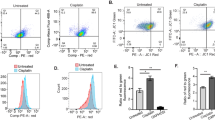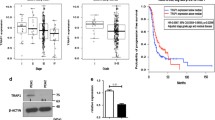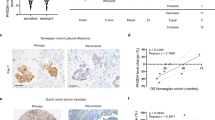Abstract
Chemoresistance to platinum-based antineoplastic agents is a consistent feature among ovarian carcinomas; however, whereas high-grade serous carcinoma (OSC) acquires resistance during chemotherapy, ovarian clear cell carcinoma (OCCC) is intrinsically resistant. The main objective of this study was to explore, in vitro and in vivo, if hepatocyte nuclear factor 1β (HNF1β) and glutaminolysis contribute for the resistance of OCCC to carboplatin through the intrinsically increased GSH bioavailability. To disclose the role of HNF1β, experiments were also performed in an OSC cell line, which does not express HNF1β. Metabolic profiles, GSH quantification, HNF1β, and γ-glutamylcysteine ligase catalytic subunit (GCLC) and modifier subunit (GCLM) expression, cell cycle, and death were assessed in ES2 cell line (OCCC) and OVCAR3 cell line (OSC); HNF1β knockdown was performed in ES2 and murine model of subcutaneous and peritoneal OCCC tumors was established to test buthionine sulphoxamine (BSO), as a sensitizer to carboplatin. Glutaminolysis is activated in ES2 and OVCAR3, though ES2 exclusively synthesizes amino acids and GSH. ES2 cells are more resistant to carboplatin than OVCAR3 and the abrogation of GSH production by BSO sensitizes ES2 to carboplatin. HNF1β regulates the expression of GCLC, but not GCLM, and consequently GSH production in ES2. In vivo, BSO prior to carboplatin reduces dramatically subcutaneous tumor size and GSH levels, as well as peritoneal dissemination. Our study discloses HNF1β as the mediator of intrinsic OCCC chemoresistance and sheds a light to re-explore a cancer adjuvant therapeutic approach using BSO to overcome the lack of efficient therapy in OCCC.









Similar content being viewed by others
References
Feeley KM, Wells M. Precursor lesions of ovarian epithelial malignancy. Histopathology. 2001;38:87–95. Available from: http://www.ncbi.nlm.nih.gov/pubmed/11207821.
Siegel R, Naishadham D, Jemal A. Cancer Statistics, 2012. Cancer J Clin. 2012;62:10–29.
Sugiyama T, Kamura T, Kigawa J, Terakawa N, Kikuchi Y, Kita T, et al. Clinical characteristics of clear cell carcinoma of the ovary: a distinct histologic type with poor prognosis and resistance to platinum-based chemotherapy. Cancer. 2000;88:2584–9. Available from: http://www.ncbi.nlm.nih.gov/pubmed/10861437.
Verhaak RGW, Tamayo P, Yang J, Hubbard D, Zhang H, Creighton CJ, et al. Prognostically relevant gene signatures of high-grade serous ovarian carcinoma. J Clin Invest. 2013;123:517–25.
Del Carmen MG, Birrer M, Schorge JO. Clear cell carcinoma of the ovary: a review of the literature. Gynecologic oncology [Internet]. Elsevier Inc.; 2012 [cited 2015 Jan 29];126:481–90. Available from: http://www.ncbi.nlm.nih.gov/pubmed/22525820
Gates C, Rice VM. Epithelial ovarian cancer: an overview. World J Transl Med. 2014;3:10–29.
Mabuchi S, Kawase C, Altomare DA, Morishige K, Sawada K, Hayashi M, et al. mTOR is a promising therapeutic target both in cisplatin-sensitive and cisplatin-resistant clear cell carcinoma of the ovary. Clin Cancer Res Off J Am Assoc Cancer Res. 2009;15:5404–13. Available from: http://www.pubmedcentral.nih.gov/articlerender.fcgi?artid=2743856&tool=pmcentrez&rendertype=abstract.
Shen H, Fridley BL, Song H, Lawrenson K, Cunningham JM. Epigenetic analysis leads to identification of HNF1B as a subtype-specific susceptibility gene for ovarian cancer. Nat Commun. 2013;4.
Lee Y-Y, Kim T-J, Kim M-J, Kim H-J, Song T, Kim MK, et al. Prognosis of ovarian clear cell carcinoma compared to other histological subtypes: a meta-analysis. Gynecologic oncology [Internet]. Elsevier Inc.; 2011 [cited 2015 Feb 27];122:541–7. Available from: http://www.ncbi.nlm.nih.gov/pubmed/21640372
Pather S, Quinn MA. Clear-cell cancer of the ovary—is it chemosensitive ? Int J Gynecol Cancer. 2005;15:432–7.
Anglesio MS, Carey MS, Köbel M, Mackay H, Huntsman DG. Clear cell carcinoma of the ovary: a report from the first Ovarian Clear Cell Symposium, June 24th, 2010. Gynecologic oncology [Internet]. Elsevier Inc.; 2011 [cited 2013 Sep 22];121:407–15. Available from: http://www.ncbi.nlm.nih.gov/pubmed/21276610
Konstantinopoulos PA, Matulonis UA. Current status and evolution of preclinical drug development models of epithelial ovarian cancer. Frontiers in Oncol. 2013;3:296. Available from: http://www.pubmedcentral.nih.gov/articlerender.fcgi?artid=3858677&tool=pmcentrez&rendertype=abstract.
Verschoor ML, Singh G. Ets-1 regulates intracellular glutathione levels: key target for resistant ovarian cancer. Mol Cancer. 2013;12:138. Available from: http://www.pubmedcentral.nih.gov/articlerender.fcgi?artid=3842663&tool=pmcentrez&rendertype=abstract.
Chaney SG, Campbell SL, Temple B, Bassett E, Wu Y, Faldu M. Protein interactions with platinum-DNA adducts: from structure to function. J Inorg Biochem. 2004;98:1551–9. Available from: http://www.ncbi.nlm.nih.gov/pubmed/15458816.
Goodisman J, Hagrman D, Tacka KA, Souid A-K. Analysis of cytotoxicities of platinum compounds. Cancer Chemother Pharmacol. 2006;57:257–67. Available from: http://www.ncbi.nlm.nih.gov/pubmed/16028101.
Unger FT, Klasen HA, Tchartchian G, de Wilde RL, Witte I. DNA damage induced by cis- and carboplatin as indicator for in vitro sensitivity of ovarian carcinoma cells. BMC Cancer. 2009;9:359. Available from: http://www.pubmedcentral.nih.gov/articlerender.fcgi?artid=2768745&tool=pmcentrez&rendertype=abstract.
Wang D, Lippard SJ. Cellular processing of platinum anticancer drugs. Nat Rev Drug Discov. 2005;4:307–20.
Dhivya H. Glutathione—a master antioxidant and an immune system modulator. 2012;1:13–5.
Matés JM, Segura JA, Martín-Rufián M, Campos-Sandoval JA, Alonso FJ, Márquez J. Glutaminase isoenzymes as key regulators in metabolic and oxidative stress against cancer. Current Mol Med. 2013;13:514–34. Available from: http://www.ncbi.nlm.nih.gov/pubmed/22934847.
Yang Y, Dieter MZ, Chen Y, Shertzer HG, Nebert DW, Dalton TP. Initial characterization of the glutamate-cysteine ligase modifier subunit Gclm(-/-) knockout mouse. Novel model system for a severely compromised oxidative stress response. J Biol Chem. 2002;277:49446–52. Available from: http://www.ncbi.nlm.nih.gov/pubmed/12384496.
Franklin CC, Backosa DS, Moharb I, White CC, Formanc JH, et al. Structure, function, and post-translational regulation of the catalytic and modifier subunits of glutamate cysteine ligase. Mol Aspects Med. 2010;30:86–98.
Kelland LR. Preclinical perspectives on platinum resistance. Drugs. 2000;59:1–8.
Estrela JM, Ortega A, Obrador E. Glutathione in cancer biology and therapy. Crit Rev Clin Lab Sci. 2006;43:143–81. Available from: http://www.ncbi.nlm.nih.gov/pubmed/16517421.
Traverso N, Ricciarelli R, Nitti M, Marengo B, Furfaro AL, Pronzato MA, et al. Role of glutathione in cancer progression and chemoresistance. Oxidative medicine and cellular longevity [Internet]. 2013;2013:972913. Available from: http://www.pubmedcentral.nih.gov/articlerender.fcgi?artid=3673338&tool=pmcentrez&rendertype=abstract
Corti A, Franzini M, Paolicchi A, Pompella A. Gamma-glutamyltransferase of cancer cells at the crossroads of tumor progression, drug resistance and drug targeting. Anticancer Res. 2010;30:1169–81. Available from: http://www.ncbi.nlm.nih.gov/pubmed/20530424/RefSource>.
Serpa J, Dias S. Metabolic cues from the microenvironment act as a major selective factor for cancer progression and metastases formation. Cell Cycle. 2011;10:180–1. Available from: http://www.landesbioscience.com/journals/cc/article/14476/.
Hanahan D, Weinberg RA. Hallmarks of cancer: the next generation. Cell Elsevier Inc. 2011;144:646–74. Available from: http://www.ncbi.nlm.nih.gov/pubmed/21376230.
Dang CV. Glutaminolysis: supplying carbon or nitrogen, or both for cancer cells? Cell Cycle. 2010;9:3884–6. Available from: http://www.landesbioscience.com/journals/cc/article/13302/.
Reynolds MR, Lane a N, Robertson B, Kemp S, Liu Y, Hill BG, et al. Control of glutamine metabolism by the tumor suppressor Rb. Oncogene [Internet]. Nature Publishing Group; 2013 [cited 2013 Jul 6];1–11. Available from: http://www.ncbi.nlm.nih.gov/pubmed/23353822
Fath MA, Ahmad IM, Smith CJ, Spence J, Spitz DR. Enhancement of carboplatin-mediated lung cancer cell killing by simultaneous disruption of glutathione and thioredoxin metabolism. Clin Cancer Res Off J Am Assoc Cancer Res. 2011;17:6206–17. Available from: http://www.pubmedcentral.nih.gov/articlerender.fcgi?artid =3186854&tool=pmcentrez&rendertype=abstract.
Watanabe T, Sagisaka H, Arakawa S, Shibaya Y, Watanabe M. A novel model of continuous depletion of glutathione in mice with L-butathione (S, R)-sulfoximine. J Toxicol Sci Toxicol Sci. 2003;28:455–69.
Meijer C, Mulder NH, Timmer-bosscha H. Relationship of cellular glutathione to the cytotoxicity and resistance of seven platinum compounds1. Cancer Res. 1992;52:6885–9.
Daye D, Wellen KE. Metabolic reprogramming in cancer: unraveling the role of glutamine in tumorigenesis. Seminars in cell & developmental biology. Elsevier Ltd; 2012;23:362–9. Available from: http://www.pubmedcentral.nih.gov/articlerender.fcgi?artid =3186854&tool=pmcentrez&rendertype=abstract.
Shen H, Fridley BL, Song H, Lawrenson K, Cunningham JM, Ramus SJ, et al. Epigenetic analysis leads to identification of HNF1B as a subtype-specific susceptibility gene for ovarian cancer. Nat Commun. 2013;4:1628. Available from: http://www.pubmedcentral.nih.gov/articlerender.fcgi?artid=3848248&tool=pmcentrez&rendertype=abstract.
Iorio E, Mezzanzanica D, Alberti P, Spadaro F, Ramoni C, D’Ascenzo S, et al. Alterations of choline phospholipid metabolism in ovarian tumor progression. Cancer Res. 2005;65:9369–76. Available from: http://www.ncbi.nlm.nih.gov/pubmed/16230400.
Ridgway ND. The role of phosphatidylcholine and choline metabolites to cell proliferation and survival. Crit Rev Biochem Mol Biol. 2013;48:20–38. Available from: http://www.ncbi.nlm.nih.gov/pubmed/16230400.
Israël M, Schwartz L. The metabolic advantage of tumor cells. Molecular cancer [Internet]. BioMed Central Ltd; 2011 [cited 2013 May 31];10:70. Available from: http://www.pubmedcentral.nih.gov/articlerender.fcgi?artid=3118193&tool=pmcentrez&rendertype=abstract
Blair SL, Heerdt P, Sachar S, Aboihoda A, Hochwald S, Cheng H, et al. Glutathione metabolism in patients with non-small cell lung cancers. Cancer Res. 1997;152:152–6.
Wu JH, Batist G. Glutathione and glutathione analogues; therapeutic potentials. Biochimica et biophysica acta [Internet]. Elsevier B.V.; 2013 [cited 2015 Feb 26];1830:3350–3. Available from: http://www.ncbi.nlm.nih.gov/pubmed/23201199
Husain K, Whitworth C, Somani SM, Rybak LP. Carboplatin-induced oxidative stress in rat cochlea. Hear Res. 2001;159:14–22. Available from: http://www.ncbi.nlm.nih.gov/pubmed/11520631.
Quintana E, Pertusa J, González R, Renau-Piqueras J. Carboplatin treatment induces dose-dependent increases in the frequency of micronuclei in Ehrlich ascites tumor cells. Mutat Res. 1994;322:55–60. Available from: http://www.ncbi.nlm.nih.gov/pubmed/7517504.
Tsuchiya A, Sakamoto M, Yasuda J, Chuma M, Ohta T, Ohki M, et al. Expression profiling in ovarian clear cell carcinoma. Am J Pathol Am Soc Investig Pathol. 2003;163:2503–12. Available from: http://linkinghub.elsevier.com/retrieve/pii/S000294401063605X.
Lee J-M, Calkins MJ, Chan K, Kan YW, Johnson JA. Identification of the NF-E2-related factor-2-dependent genes conferring protection against oxidative stress in primary cortical astrocytes using oligonucleotide microarray analysis. J Biol Chem. 2003;278:12029–38.
Singhal SS, Yadav S, Roth C, Singhal J. RLIP76: a novel glutathione-conjugate and multi-drug transporter. Biochem Pharmacol. 2009;77:761–9. Available from: http://www.pubmedcentral.nih.gov/articlerender.fcgi?artid =2664079&tool=pmcentrez&rendertype=abstract.
Pompella A, De Tata V, Paolicchi A, Zunino F. Expression of gamma-glutamyltransferase in cancer cells and its significance in drug resistance. Biochem Pharmacol. 2006;71:231–8. Available from: http://www.ncbi.nlm.nih.gov/pubmed/16303117.
Jerremalm E, Wallin I, Yachnin J, Ehrsson H. Oxaliplatin degradation in the presence of important biological sulphur-containing compounds and plasma ultrafiltrate. European J Pharm Sci Off J European Federation for Pharm Sci. 2006;28:278–83.
Green JA, Vistica DT, Young RC, Hamilton TC, Rogan AM, Ozols RF. Potentiation of melphalan cytotoxicity in human ovarian cancer cell lines by glutathione depletion. Cancer Res. 1984;44:5427–31.
Russo A, Degraff W, Friedman N, Mitchell JB. Selective modulation of glutathione levels in human normal versus tumor cells and subsequent differential response to chemotherapy drugs. Cancer Res. 1986;46:2845–8.
Fojo A, Hamilton T, Young R, Ozols R. Multidrug resistance in ovarian cancer. Cancer. 1987;60:2075–80.
Nolin TD, McMenamin ME, Himmelfarb J. Simultaneous determination of total homocysteine, cysteine, cysteinylglycine, and glutathione in human plasma by high-performance liquid chromatography: application to studies of oxidative stress. J Chromatogr B Analyt Technol Biomed Life Sci. 2007;852:554–61. Available from: http://www.pubmedcentral.nih.gov/articlerender.fcgi?artid = 1959569&tool=pmcentrez&rendertype=abstract.
Acknowledgments
The authors would like to thank to Instituto Português de Oncologia de Lisboa, Francisco Gentil, EPE (IPOLFG, EPE) for partially supporting the project, as well as to TVI in the context of Familial and individual cancer risk project. The NMR spectrometers are part of the National NMR Facility supported by Fundação para a Ciência e a Tecnologia (RECI/BBB-BQB/0230/2012). Sofia Gouveia-Fernandes acknowledges the fellowship from Liga Portuguesa Contra o Cancro and Roche Portugal (LPCC-Roche 2012). Luis G. Gonçalves acknowledges the fellowship from the project RECI/BBB-BQB/0230/2012 of Fundação para a Ciência e a Tecnologia. The authors would like to thank Duarte Barral (PhD; CEDOC-NOVA Medical School) for providing the access to the animal facility from Instituto Gulbenkian de Ciência, Oeiras.
Author information
Authors and Affiliations
Corresponding author
Electronic supplementary material
Below is the link to the electronic supplementary material.
Supplementary Figure 1
BSO exposure reduces CYS-GLY and GSH levels in ES2 and OVCAR3. (JPEG 29 kb)
Rights and permissions
About this article
Cite this article
Lopes-Coelho, F., Gouveia-Fernandes, S., Gonçalves, L.G. et al. HNF1β drives glutathione (GSH) synthesis underlying intrinsic carboplatin resistance of ovarian clear cell carcinoma (OCCC). Tumor Biol. 37, 4813–4829 (2016). https://doi.org/10.1007/s13277-015-4290-5
Received:
Accepted:
Published:
Issue Date:
DOI: https://doi.org/10.1007/s13277-015-4290-5




